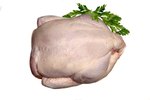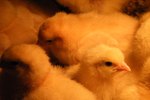Things You'll Need
Iodine solution
Ostrich pellets or ground meal
Shallow containers
Alfalfa
Grit and gravel
Brooder
Cleaning supplies
How to Care for Baby Ostriches. Ostrich farming is becoming popular in the United States. Some people raise ostriches for the meat while other people raise ostriches for the oil that is used in cosmetics or for the feathers. If you want to get into ostrich farming, you will have to learn how to care for baby ostriches.
Caring for the Chick
Allow the chick to hatch on its own; do not help the eggs hatch. Ostrich chicks need to hatch from the eggs on their own when they are mature enough to be healthy. This may take several days.
Wash the chick in 7 percent iodine solution to help prevent against bacterial contamination, once the chick is hatched.
Hobble your chick's legs if they are having difficulty walking. Speak to your vet or a knowledgeable ostrich farmer for more information about this step.
Providing Nutrition
Refrain from providing food or water until your ostrich chicks are 6 to 8 days old. Ostrich chicks have a great deal of fluid in their tissues that needs to be absorbed so they can stay healthy and develop properly. However, some experts suggest feeding baby ostriches yogurt around day 2 or 3.
Provide ostrich pellets or roughly ground meal several times a day in shallow dishes when your chicks are old enough.
Give the chicks alfalfa and clover cuttings without the stems. The cuttings should not be wilted. If your provide cuttings, you will have to provide grit and gravel for the ostriches to eat to aid in proper digestion. Some experts put a few pebbles (about the size of a grain of rice) into the feed, while other experts simply provide the grit on the ground.
Place water for your ostriches in shallow containers that can't tip over. The containers should be at a proper height so the birds can't fall into them, but low enough so they can drink easily. One water bowl should be provided for every three food containers. In addition, you may need to put something shiny into the water for the first few days to attract the baby ostriches to the water bowl.
Add a vitamin supplement to your ostrich chicks' diet for the first few weeks.
The Brooder
Maintain the temperature within the brooder at 88 to 92 degrees Fahrenheit during the first ten days of your ostrich's life. Then, until week three, lower it to 80 to 85 degrees Fahrenheit. After week 3, the brooder's temperature should 70 to 80 F. The temperature should be kept as consistent as possible.
Clean the brooder every day to keep the ostriches healthy. Provide a washable mat that can't be eaten by the chicks. Do not provide any litter, hay or sawdust at the bottom of the brooder since baby ostriches can eat these items and die.
Move your chicks to a safe and enclosed pen during the day when your chicks are a few weeks old. Remember, ostrich chicks need 40 square feet of pen space per chick so the chicks can run and properly develop.
Tips
Newly hatched chicks do better when placed with slightly older chicks to teach them how to eat and drink.
Warnings
These steps should never be used in place of talking to a veterinarian a knowledgeable ostrich farmer.
Writer Bio
This article was written by the CareerTrend team, copy edited and fact checked through a multi-point auditing system, in efforts to ensure our readers only receive the best information. To submit your questions or ideas, or to simply learn more about CareerTrend, contact us [here](http://careertrend.com/about-us).





